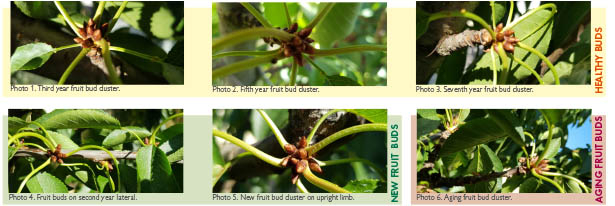As late cherry varieties such as Sweetheart, Regina, Staccato and others are harvested from the later areas in Tasmania and the mainland, cherries of exceptional quality have been seen in supermarkets and retail outlets across the country this month—despite rain during the season.
Calcium is key to fruit quality
As scientists inform us: calcium in the fruit is important to help protect against rain cracking and it is essential in maintaining fruit quality.
That is why it is important to not let fruit bud clusters on a cherry tree remain more than ten years, as the uptake of calcium will be restricted and fruit quality is adversely affected.
Remove ageing fruit bud clusters
Post season it is important to identify ageing fruit bud clusters and consider removing them; and to replace older fruiting wood with newer limbs and laterals. This should lead to fruit of higher quality and the likelihood of rain cracking will also be reduced.
It does not matter which growing system the orchard is based on (vase, steep leader, Tatura trellis, spindle, Upright Fruiting Offshoots (UFO) etc.) the principle is the same: remove the older fruit bud clusters by cutting out the wood that they are growing on to gain the best quality fruit.
Free pass only lasts a decade
It is very easy during the first five to ten years of growth of a cherry tree to do very little in the way of pruning and tree training and still manage to harvest top quality fruit.
However, after about ten years it becomes imperative to take action. If you don't, you run the risk of playing catch-up in order to maintain fruit quality.
Photo examples
Photos 1,2, and 3 above show healthy fruit buds, photos 4 and 5 show new fruit bud cluster, and photo 6 shows an example of fruit bud cluster that should be removed, along with the wood it is growing on.
The centre bud in a cluster is usually a leaf bud, each of the fruit buds may have between one and five flowers.
Take action
After leaf fall it will be easy to see and locate the old buds on the tree and plan to take action of removal and regeneration.
See this article and photos in Tree Fruit Jan 2022






















